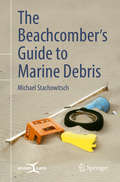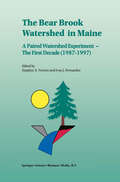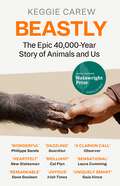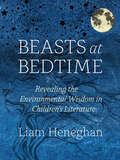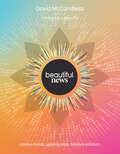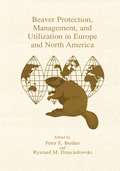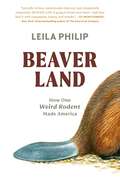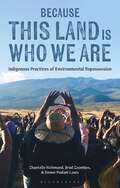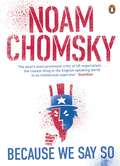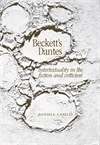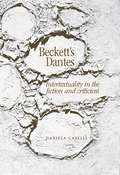- Table View
- List View
The Beachcomber’s Guide to Marine Debris
by Michael StachowitschThis richly illustrated book serves as the ideal guide to the items that litter the world’s beaches. Forget sea shells and other fauna and flora. Here, you will find what a beachcomber is actually most likely to encounter these days: glass, plastic, wood, metal, paper, oil, and other sources of marine pollution!Complete with nearly 700 photographs, this guide shows the full range of marine debris items, each presented with insight and a pinch of humor. In addition, the author provides full details about these items. You will learn everything worth knowing about them. This includes not just their sources and decomposition stages. Discover the threat each item poses to these beautiful environments as well as prevention strategies, clean-up recommendations, alternative products, and recycling and upcycling ideas.Beyond the aesthetic issue, marine debris poses a threat to wildlife, human health, and economic welfare. This book arms you with the knowledge you need to combat these disgraceful and often hazardous eyesores. Become a beach detective! Travel the world’s most beloved tourist destinations with this ultimate beach read and help restore these fascinating environments to their natural beauty.
Beaches and Coasts
by Richard A. Davis Jr. Duncan M. FitzgeraldCoastlines of the world are as diverse as any geological setting on Earth. Beaches and Coasts is an exciting and unique new textbook that provides an exhaustive treatment of the world's different coasts and details the highly varied processes that have shaped them. Having conducted research on coastlines throughout the world, the authors draw on a wealth of experience that broadens the content of chapters and provides for numerous and varied examples. The book furnishes a basic understanding of the tectonic framework, hydrographic regime, climatic setting, and geologic materials that determine the morphology of a coast. Individual chapters are devoted to major coastal environments such as barriers, tidal inlets, marshes, estuaries, lagoons, deltas, glaciated coasts, rocky coasts and many others. Beaches and Coasts provides the necessary content for teaching a broad coastal geology course. Though designed for introductory students, its comprehensive treatment of coastal topics will make it appropriate for many upper level courses. Exciting and unique textbook that provides an exhaustive treatment of the world's different coasts and details the highly varied processes that have shaped them. The authors draw on a wealth of experience that broadens the content of chapters and provides for numerous and varied examples. Provides a basic understanding of the tectonic framework, hydrographic regime, climatic setting, and geologic materials that determine the morphology of a coast. Individual chapters are devoted to major coastal environments such as barriers, tidal inlets, marshes, estuaries, lagoons, deltas, glaciated coasts, rocky coasts, and many others. Provides comprehensive content for teaching a broad coastal geology course for both introductory and upper level courses.
Beaches and Coasts
by Richard A. Davis Jr. Duncan M. FitzgeraldA new edition of a unique textbook that provides an exhaustive treatment of the world's different coasts—with focus on climate change sea-level rise Coastlines of the world are as diverse and complex as any geological setting on Earth, and understanding them is extremely important. Beaches and Coasts, Second Edition is an exciting and unique textbook that covers the world’s different coasts and details the highly varied processes that have shaped them. This new edition emphasizes the future susceptibility of coast to climate driven stresses and decreasing sediment supplies, and considers various aspects of coastal management that are and/or that need to be undertaken. Seeking to better educate students and readers about the sustainability of coast and coastal environments, this exciting and unique book offers enlightening coverage of: the Earth’s mobile crust; sediments of coastal environments; impacts of sea level change; weather systems and the effects of storms; the influence of wave energy and different tidal regimes; river deltas; coastal bays; estuaries and lagoons; tidal flats; coastal wetlands; beach and nearshore areas; coastal barriers; tidal inlets; glaciated coasts; and rocky coasts. Takes an extensive look at the world's varied coasts and covers the many processes that have shaped them over time Shows how coastal processes and landform evolution are expected to be impacted by climate change Includes new coverage of Hurricane Katrina and the 2005 flooding of New Orleans, Hurricane Sandy and its affect on New York and the earthquake and tsunami in the Indian Ocean and Tohoku Lavishly illustrated with over 400 color photographs and figures Draws on a wealth of author experience that broadens the content of chapters and provides for numerous and varied examples Beaches and Coasts, Second Edition is an excellent text for undergraduate and graduate students of coastal geology, coastal processes and coastal environments.
Beaches and Coasts
by Richard A. Davis Jr. Duncan M. FitzgeraldA new edition of a unique textbook that provides an exhaustive treatment of the world's different coasts—with focus on climate change sea-level rise Coastlines of the world are as diverse and complex as any geological setting on Earth, and understanding them is extremely important. Beaches and Coasts, Second Edition is an exciting and unique textbook that covers the world’s different coasts and details the highly varied processes that have shaped them. This new edition emphasizes the future susceptibility of coast to climate driven stresses and decreasing sediment supplies, and considers various aspects of coastal management that are and/or that need to be undertaken. Seeking to better educate students and readers about the sustainability of coast and coastal environments, this exciting and unique book offers enlightening coverage of: the Earth’s mobile crust; sediments of coastal environments; impacts of sea level change; weather systems and the effects of storms; the influence of wave energy and different tidal regimes; river deltas; coastal bays; estuaries and lagoons; tidal flats; coastal wetlands; beach and nearshore areas; coastal barriers; tidal inlets; glaciated coasts; and rocky coasts. Takes an extensive look at the world's varied coasts and covers the many processes that have shaped them over time Shows how coastal processes and landform evolution are expected to be impacted by climate change Includes new coverage of Hurricane Katrina and the 2005 flooding of New Orleans, Hurricane Sandy and its affect on New York and the earthquake and tsunami in the Indian Ocean and Tohoku Lavishly illustrated with over 400 color photographs and figures Draws on a wealth of author experience that broadens the content of chapters and provides for numerous and varied examples Beaches and Coasts, Second Edition is an excellent text for undergraduate and graduate students of coastal geology, coastal processes and coastal environments.
Beam Diagnostics in Superconducting Accelerating Cavities: The Extraction of Transverse Beam Position from Beam-Excited Higher Order Modes (Springer Theses)
by Pei ZhangAn energetic charged particle beam introduced to an rf cavity excites a wakefield therein. This wakefield can be decomposed into a series of higher order modes and multipoles, which for sufficiently small beam offsets are dominated by the dipole component. This work focuses on using these dipole modes to detect the beam position in third harmonic superconducting S-band cavities for light source applications. A rigorous examination of several means of analysing the beam position based on signals radiated to higher order modes ports is presented. Experimental results indicate a position resolution, based on this technique, of 20 microns over a complete module of 4 cavities. Methods are also indicated for improving the resolution and for applying this method to other cavity configurations. This work is distinguished by its clarity and potential for application to several other international facilities. The material is presented in a didactic style and is recommended both for students new to the field, and for scientists well-versed in the field of rf diagnostics.
The Bear Brook Watershed in Maine: The First Decade (1987–1997)
by Ivan J. Fernandez Stephen A. NortonThe Bear Brook Watershed in Maine (BBWM) is a long-term, whole-watershed study examining the effects of experimentally elevated N and S deposition on a treated watershed, in comparison to the adjacent reference watershed. The study is in a northern New England, USA, forested ecosystem, and focuses on soil and stream hydrological and biogeochemical processes, and chemical responses of vegetation. Relative to the reference watershed, the treated ecosystem has migrated biogeochemically towards N saturation, and soil and stream acidification. Some of the responses to N amendments were not expected nor predicted by available models.
Bear River: Last Chance to Change Course
by Craig DentonCraig Denton notes, “Water will be the primary political, social, and economic issue in the Intermountain West in the twenty-first century.” Urban Utah thirsts for the Great Salt Lake principal source, the Bear River. Plans abound to divert it for a rapidly growing Wasatch Front, as the last good option for future water. But is it? Who now uses the river and how? Who are its stakeholders? What does the Bear mean to them? What is left for further use? How do we measure the Bear's own interest, give it a voice in decisions? Craig Denton's documentary takes on these questions. He tells the story of the river and the people, of many sorts, with diverse purposes, who live and depend on it. Bear River begins in alpine snowfields, lakes, and creeks in the Uinta Mountains, flows north through Wyoming, loops south in Idaho, and enters the inland sea by way of the an environmentally critical bird refuge. Along the way it has many uses: habitat, farms, electricity, recreation, lawns and homes. Denton researches the natural and human history of the river, photographed it, interviewed many stakeholders, and tried to capture the river perspective. His photographs, printed as crisp duotones, carry us downstream, ultimately to big questions, begging to be answered soon, about what we should and can make of the Bear River. Denton writes, Gravity my engine, Water my soul. I am the teller of life and deep time. You would measure me. Sever me. Own me. In your name. Let me flow In your imagination That I may speak.
Bears of the North: A Year Inside Their Worlds
by Wayne LynchAn unprecedented visual and scientific journey into the secret world of bears.In Bears of the North, renowned wildlife photographer, naturalist, and bestselling author Wayne Lynch offers us a work of scintillating science and stunning beauty. Following polar bears, brown bears, and American and Asiatic black bears through the seasons, this journey is an insider's view of hibernation's mysteries and the birth of cubs in winter; the mating rituals and voracious appetites of spring; hunting, fishing, and encounters with neighbors during summer; and the feeding frenzy and exuberant play of autumn. Dispelling the stereotypes and untruths—but none of the magic—surrounding these magnificent animals, Lynch comments on the latest scientific discoveries related to the biology, behavior, and ecology of bears. He describes how satellite telemetry has revealed the purpose behind the meanderings of bears and the great distances they sometimes cover on land and in water. He also shows how DNA analysis can teach us about the relatedness of bears within a population, even revealing the identity of a particular cub's father. Taking us out into the wilds of the tundra and forests to share his firsthand observations of the marvelous bears of the Northern Hemisphere, Lynch describes their survival strategies and the threats they face from habitat fragmentation and global climate change. Lynch's fascinating narrative is enhanced by over 150 gorgeous, original color photographs that capture bears in their habitats, including appearances of the elusive moon bear, fierce polar bear battles, and rare images of mothers' intimate moments with their cubs. Informed by Lynch's nearly forty years of experience observing and photographing bears in the wild, and aided by sophisticated digital photo technologies, Bears of the North is an unrivaled collection of enthralling and informative portraits of bears in their natural environments.
Bears of the North: A Year Inside Their Worlds
by Wayne LynchAn unprecedented visual and scientific journey into the secret world of bears.In Bears of the North, renowned wildlife photographer, naturalist, and bestselling author Wayne Lynch offers us a work of scintillating science and stunning beauty. Following polar bears, brown bears, and American and Asiatic black bears through the seasons, this journey is an insider's view of hibernation's mysteries and the birth of cubs in winter; the mating rituals and voracious appetites of spring; hunting, fishing, and encounters with neighbors during summer; and the feeding frenzy and exuberant play of autumn. Dispelling the stereotypes and untruths—but none of the magic—surrounding these magnificent animals, Lynch comments on the latest scientific discoveries related to the biology, behavior, and ecology of bears. He describes how satellite telemetry has revealed the purpose behind the meanderings of bears and the great distances they sometimes cover on land and in water. He also shows how DNA analysis can teach us about the relatedness of bears within a population, even revealing the identity of a particular cub's father. Taking us out into the wilds of the tundra and forests to share his firsthand observations of the marvelous bears of the Northern Hemisphere, Lynch describes their survival strategies and the threats they face from habitat fragmentation and global climate change. Lynch's fascinating narrative is enhanced by over 150 gorgeous, original color photographs that capture bears in their habitats, including appearances of the elusive moon bear, fierce polar bear battles, and rare images of mothers' intimate moments with their cubs. Informed by Lynch's nearly forty years of experience observing and photographing bears in the wild, and aided by sophisticated digital photo technologies, Bears of the North is an unrivaled collection of enthralling and informative portraits of bears in their natural environments.
Beastly: A New History of Animals and Us
by Keggie CarewSHORTLISTED FOR THE WAINWRIGHT PRIZE FOR CONSERVATION A BOOK OF THE YEAR FOR THE FINANCIAL TIMES, WATERSTONES AND BBC HISTORY MAGAZINE A NEXT BIG IDEA CLUB MUST READ Beastly is the 40,000-year story of our changing kinship with the animal world - from the smallest microbe to the largest creature that ever lived. Exploring this relationship through history, culture, science and inspiring examples, Carew makes the passionate case that animals are the key to the planet's future health, but only if we can save them.
Beasts at Bedtime: Revealing the Environmental Wisdom in Children’s Literature
by Liam HeneghanTalking lions, philosophical bears, very hungry caterpillars, wise spiders, altruistic trees, companionable moles, urbane elephants: this is the magnificent menagerie that delights our children at bedtime. Within the entertaining pages of many children’s books, however, also lie profound teachings about the natural world that can help children develop an educated and engaged appreciation of the dynamic environment they inhabit. In Beasts at Bedtime, scientist (and father) Liam Heneghan examines the environmental underpinnings of children’s stories. From Beatrix Potter to Harry Potter, Heneghan unearths the universal insights into our inextricable relationship with nature that underlie so many classic children’s stories. Some of the largest environmental challenges in coming years—from climate instability, the extinction crisis, freshwater depletion, and deforestation—are likely to become even more severe as this generation of children grows up. Though today’s young readers will bear the brunt of these environmental calamities, they will also be able to contribute to environmental solutions if prepared properly. And all it takes is an attentive eye: Heneghan shows how the nature curriculum is already embedded in bedtime stories, from the earliest board books like The Rainbow Fish to contemporary young adult classics like The Hunger Games. Beasts at Bedtime is an awakening to the vital environmental education children’s stories can provide—from the misadventures of The Runaway Bunny to more overt tales like The Lorax. Heneghan serves as our guide, drawing richly upon his own adolescent and parental experiences, as well as his travels in landscapes both experienced and imagined. Organized into thematic sections, the work winds its way through literary forests, colorful characters, and global environments. This book enthralls as it engages. Heneghan as a guide is as charming as he is insightful, showing how kids (and adults) can start to experience the natural world in incredible ways from the comfort of their own rooms. Beasts at Bedtime will help parents, teachers, and guardians extend those cozy times curled up together with a good book into a lifetime of caring for our planet.
Beasts at Bedtime: Revealing the Environmental Wisdom in Children’s Literature
by Liam HeneghanTalking lions, philosophical bears, very hungry caterpillars, wise spiders, altruistic trees, companionable moles, urbane elephants: this is the magnificent menagerie that delights our children at bedtime. Within the entertaining pages of many children’s books, however, also lie profound teachings about the natural world that can help children develop an educated and engaged appreciation of the dynamic environment they inhabit. In Beasts at Bedtime, scientist (and father) Liam Heneghan examines the environmental underpinnings of children’s stories. From Beatrix Potter to Harry Potter, Heneghan unearths the universal insights into our inextricable relationship with nature that underlie so many classic children’s stories. Some of the largest environmental challenges in coming years—from climate instability, the extinction crisis, freshwater depletion, and deforestation—are likely to become even more severe as this generation of children grows up. Though today’s young readers will bear the brunt of these environmental calamities, they will also be able to contribute to environmental solutions if prepared properly. And all it takes is an attentive eye: Heneghan shows how the nature curriculum is already embedded in bedtime stories, from the earliest board books like The Rainbow Fish to contemporary young adult classics like The Hunger Games. Beasts at Bedtime is an awakening to the vital environmental education children’s stories can provide—from the misadventures of The Runaway Bunny to more overt tales like The Lorax. Heneghan serves as our guide, drawing richly upon his own adolescent and parental experiences, as well as his travels in landscapes both experienced and imagined. Organized into thematic sections, the work winds its way through literary forests, colorful characters, and global environments. This book enthralls as it engages. Heneghan as a guide is as charming as he is insightful, showing how kids (and adults) can start to experience the natural world in incredible ways from the comfort of their own rooms. Beasts at Bedtime will help parents, teachers, and guardians extend those cozy times curled up together with a good book into a lifetime of caring for our planet.
Beasts at Bedtime: Revealing the Environmental Wisdom in Children’s Literature
by Liam HeneghanTalking lions, philosophical bears, very hungry caterpillars, wise spiders, altruistic trees, companionable moles, urbane elephants: this is the magnificent menagerie that delights our children at bedtime. Within the entertaining pages of many children’s books, however, also lie profound teachings about the natural world that can help children develop an educated and engaged appreciation of the dynamic environment they inhabit. In Beasts at Bedtime, scientist (and father) Liam Heneghan examines the environmental underpinnings of children’s stories. From Beatrix Potter to Harry Potter, Heneghan unearths the universal insights into our inextricable relationship with nature that underlie so many classic children’s stories. Some of the largest environmental challenges in coming years—from climate instability, the extinction crisis, freshwater depletion, and deforestation—are likely to become even more severe as this generation of children grows up. Though today’s young readers will bear the brunt of these environmental calamities, they will also be able to contribute to environmental solutions if prepared properly. And all it takes is an attentive eye: Heneghan shows how the nature curriculum is already embedded in bedtime stories, from the earliest board books like The Rainbow Fish to contemporary young adult classics like The Hunger Games. Beasts at Bedtime is an awakening to the vital environmental education children’s stories can provide—from the misadventures of The Runaway Bunny to more overt tales like The Lorax. Heneghan serves as our guide, drawing richly upon his own adolescent and parental experiences, as well as his travels in landscapes both experienced and imagined. Organized into thematic sections, the work winds its way through literary forests, colorful characters, and global environments. This book enthralls as it engages. Heneghan as a guide is as charming as he is insightful, showing how kids (and adults) can start to experience the natural world in incredible ways from the comfort of their own rooms. Beasts at Bedtime will help parents, teachers, and guardians extend those cozy times curled up together with a good book into a lifetime of caring for our planet.
Beasts at Bedtime: Revealing the Environmental Wisdom in Children’s Literature
by Liam HeneghanTalking lions, philosophical bears, very hungry caterpillars, wise spiders, altruistic trees, companionable moles, urbane elephants: this is the magnificent menagerie that delights our children at bedtime. Within the entertaining pages of many children’s books, however, also lie profound teachings about the natural world that can help children develop an educated and engaged appreciation of the dynamic environment they inhabit. In Beasts at Bedtime, scientist (and father) Liam Heneghan examines the environmental underpinnings of children’s stories. From Beatrix Potter to Harry Potter, Heneghan unearths the universal insights into our inextricable relationship with nature that underlie so many classic children’s stories. Some of the largest environmental challenges in coming years—from climate instability, the extinction crisis, freshwater depletion, and deforestation—are likely to become even more severe as this generation of children grows up. Though today’s young readers will bear the brunt of these environmental calamities, they will also be able to contribute to environmental solutions if prepared properly. And all it takes is an attentive eye: Heneghan shows how the nature curriculum is already embedded in bedtime stories, from the earliest board books like The Rainbow Fish to contemporary young adult classics like The Hunger Games. Beasts at Bedtime is an awakening to the vital environmental education children’s stories can provide—from the misadventures of The Runaway Bunny to more overt tales like The Lorax. Heneghan serves as our guide, drawing richly upon his own adolescent and parental experiences, as well as his travels in landscapes both experienced and imagined. Organized into thematic sections, the work winds its way through literary forests, colorful characters, and global environments. This book enthralls as it engages. Heneghan as a guide is as charming as he is insightful, showing how kids (and adults) can start to experience the natural world in incredible ways from the comfort of their own rooms. Beasts at Bedtime will help parents, teachers, and guardians extend those cozy times curled up together with a good book into a lifetime of caring for our planet.
Beautiful News: Positive Trends, Uplifting Stats, Creative Solutions
by David McCandlessIn this fascinating follow-up to the bestselling Information is Beautiful and Knowledge is Beautiful, the king of infographics David McCandless uses spectacular visuals to give us all a bit of good news.
Beauty and the Male Body in Byzantium: Perceptions and Representations in Art and Text
by M. HatzakiA neglected aspect of Byzantium, physical beauty appears as a quality with an unmistakable dark side, relating ambiguously to notions of power, goodness, evil, masculinity, effeminacy, life and death. Examined as an attribute of the human and, in particular, of the male body, this study of beauty refines our understanding of the Byzantine world.
The Beauty of Geology: Art of Geology Mapping in China Over a Century
by Chenyang Li Liqiong Jia Xuan WuThis open access book contains a collection of rare geologic maps and figures made by Chinese geologists in the last century. Preserved in National Geological Archives of China, these artworks demonstrate the development and innovation of geological mapping technology in China in the past 100 years. The collections are highly scientific and artistic, with most of the hand-drawn maps featured with traditional Chinese painting techniques, while the newer ones being more accurate and embedded with more scientific information with the aid of computer techniques.
Beaver Protection, Management, and Utilization in Europe and North America
by Peter E. Busher Ryszard M. DzieciolowskiBy the end of the 19th century both beaver species had been extirpated from large portions of their native ranges. The global decline in beaver populations was the direct re sult of exploitation by humans. Now, at the end of the 20th century, protection, manage ment, and reintroduction programs, coupled with a decline in the demand for beaver fur and other products, have allowed beaver populations to increase dramatically. Since bea vers actively modify their local environment their activities can conflict with human land use. Because of this, the beaver, once considered a unique and exotic component of wet lands, is now often considered a nuisance species. The history, as well as the current status, of beaver populations in Europe and North America provide insight into how con servation programs work, and into how humans and wildlife interact. The initial plenary lecture of the Euro-American Mammal Congress (July, 1998) was presented by Dr. Michael L. Rosenzweig, a professor at the University of Arizona. Dr. Rosenzweig discussed how humans have used and continue to use natural resources, in cluding wildlife and wildland. He provided evidence indicating that the current model of reservation conservation could not provide a long-term solution to the human-wild life/wildland conflict. Dr. Rosenzweig emphasized that what is required is a move away from purely exploitive activities (I would call this exploitive ecology) and the develop ment of a reconciliation ecology with wildlife.
Beaverland: How One Weird Rodent Made America
by Leila PhilipAn intimate and revelatory dive into the world of the beaver—the wonderfully weird rodent that has surprisingly shaped American history and may save its ecological future. From award-winning writer Leila Philip, Beaverland is a masterful work of narrative science writing, a book that highlights, though history and contemporary storytelling, how this weird rodent plays an oversized role in American history and its future. She follows fur trappers who lead her through waist high water, fur traders and fur auctioneers, as well as wildlife managers, PETA activists, Native American environmental vigilantes, scientists, engineers, and the colorful group of activists known as beaver believers. Beginning with the early trans-Atlantic trade in North America, Leila Philip traces the beaver&’s profound influence on our nation&’s early economy and feverish western expansion, its first corporations and multi-millionaires. In her pursuit of this weird and wonderful animal, she introduces us to people whose lives are devoted to the beaver, including a Harvard scientist from the Blackfeet Reservation in Montana, who uses drones to create 3-dimensional images of beaver dams; and an environmental restoration consultant in the Chesapeake whose nickname is the &“beaver whisperer&”. What emerges is a poignant personal narrative, a startling portrait of the secretive world of the contemporary fur trade, and an engrossing ecological and historical investigation of these heroic animals who, once trapped to the point of extinction, have returned to the landscape as one of the greatest conservation stories of the 20th century. Beautifully written and impeccably researched, Beaverland reveals the profound ways in which one odd creature and the trade surrounding it has shaped history, culture, and our environment. The New York Times Editors' Choice NPR Science Friday Book Club Selection
Because This Land is Who We Are: Indigenous Practices of Environmental Repossession
by Chantelle RichmondBecause This Land Is Who We Are is an exploration of environmental repossession, told through a collaborative case study approach, and engaging with Indigenous communities in Canada (Anishinaabe), Hawai'i (Kanaka Maoli) and Aotearoa (Maori). The co-authors are all Indigenous scholars, community leaders and activists who are actively engaged in the movements underway in these locations, and able to describe the unique and common strategies of repossession practices taking place in each community. This open access book celebrates Indigenous ways of knowing, relating to and honouring the land, and the authors' contributions emphasize the efforts taking place in their own Indigenous land. Through engagement with these varying cultural imperatives, the wider goal of Because This Land Is Who We Are is to broaden both theoretical and applied concepts of environmental repossession, and to empower any Indigenous community around the world which is struggling to assert its rights to land.The ebook editions of this book are available open access under a CC BY-NC-ND 4.0 licence on bloomsburycollections.com. Open access was funded by Knowledge Unlatched.
Because This Land is Who We Are: Indigenous Practices of Environmental Repossession
by Chantelle RichmondBecause This Land Is Who We Are is an exploration of environmental repossession, told through a collaborative case study approach, and engaging with Indigenous communities in Canada (Anishinaabe), Hawai'i (Kanaka Maoli) and Aotearoa (Maori). The co-authors are all Indigenous scholars, community leaders and activists who are actively engaged in the movements underway in these locations, and able to describe the unique and common strategies of repossession practices taking place in each community. This open access book celebrates Indigenous ways of knowing, relating to and honouring the land, and the authors' contributions emphasize the efforts taking place in their own Indigenous land. Through engagement with these varying cultural imperatives, the wider goal of Because This Land Is Who We Are is to broaden both theoretical and applied concepts of environmental repossession, and to empower any Indigenous community around the world which is struggling to assert its rights to land.The ebook editions of this book are available open access under a CC BY-NC-ND 4.0 licence on bloomsburycollections.com. Open access was funded by Knowledge Unlatched.
Because We Say So (City Lights Open Media Ser.)
by Noam ChomskyBecause We Say So is Noam Chomsky's essential counter punch to American hegemony.In 1962, the eminent statesman Dean Acheson enunciated a principle that has dominated global politics ever since: that no legal issue arises when the United States responds to a challenge to its 'power, position, and prestige'. In short, whatever the world may think, U.S. actions are legitimate because they say so. Spanning the impact of Edward Snowden's whistleblowing and Palestinian-Israeli relations to deeper reflections on political philosophy and the importance of a commons to democracy, Because We Say So takes American imperialism head on.'Noam Chomsky is one of a small band of individuals fighting a whole industry. And that makes him not only brilliant, but heroic' Arundhati Roy'The world's greatest public intellectual' Observer
The Becher Wetlands - A Ramsar Site: Evolution of Wetland Habitats and Vegetation Associations on a Holocene Coastal Plain, South-Western Australia (Wetlands: Ecology, Conservation and Management #1)
by Christine SemeniukThis is a landmark study of the Holocene evolution and functioning of a suite of seasonal wetland basins in the temperate coastal zone of Western Australia, which were added to the the Ramsar List of Wetlands of International Importance because of their setting, their method of formation and deepening, their history of infilling, their complex hydrological mechanisms, and their dynamic hydrochemical and vegetation responses.
Beckett's Dantes: Intertextuality in the fiction and criticism (PDF)
by Daniela CaselliBeckett's Dantes: Intertextuality in the Fiction and Criticism is the first study in English on the literary relation between Beckett and Dante. It is an innovative reading of Samuel Beckett and Dante's works and a critical engagement with contemporary theories of intertextuality. It is an informative intertextual reading of Beckett's work, detecting previously unknown quotations, allusions to, and parodies of Dante in Beckett's fiction and criticism. The volume interprets Dante in the original Italian (as it appears in Beckett), translating into English all Italian quotations. It benefits from a multilingual approach based on Beckett's published works in English and French, and on manuscripts (which use English, French, German and Italian). Through a close reading of Beckett's fiction and criticism, the book will argue that Dante is both assumed as an external source of literary and cultural authority in Beckett's work, and also participates in Beckett's texts' sceptical undermining of authority. Moreover, the book demonstrates that the many references to various 'Dantes' produce 'Mr Beckett' as the figure of the author responsible for such a remarkably interconnected oeuvre. The book is aimed at the scholarly communities interested in literatures in English, literary and critical theory, comparative literature and theory, French literature and theory and Italian studies. Its jargon-free style will also attract third-year or advanced undergraduate students, and postgraduate students, as well as those readers interested in the unusual relationship between one of the greatest writers of the twentieth century and the medieval author who stands for the very idea of the Western canon.
Beckett's Dantes: Intertextuality in the fiction and criticism
by Daniela CaselliBeckett's Dantes: Intertextuality in the Fiction and Criticism is the first study in English on the literary relation between Beckett and Dante. It is an innovative reading of Samuel Beckett and Dante's works and a critical engagement with contemporary theories of intertextuality. It is an informative intertextual reading of Beckett's work, detecting previously unknown quotations, allusions to, and parodies of Dante in Beckett's fiction and criticism. The volume interprets Dante in the original Italian (as it appears in Beckett), translating into English all Italian quotations. It benefits from a multilingual approach based on Beckett's published works in English and French, and on manuscripts (which use English, French, German and Italian). Through a close reading of Beckett's fiction and criticism, the book will argue that Dante is both assumed as an external source of literary and cultural authority in Beckett's work, and also participates in Beckett's texts' sceptical undermining of authority. Moreover, the book demonstrates that the many references to various 'Dantes' produce 'Mr Beckett' as the figure of the author responsible for such a remarkably interconnected oeuvre. The book is aimed at the scholarly communities interested in literatures in English, literary and critical theory, comparative literature and theory, French literature and theory and Italian studies. Its jargon-free style will also attract third-year or advanced undergraduate students, and postgraduate students, as well as those readers interested in the unusual relationship between one of the greatest writers of the twentieth century and the medieval author who stands for the very idea of the Western canon.
